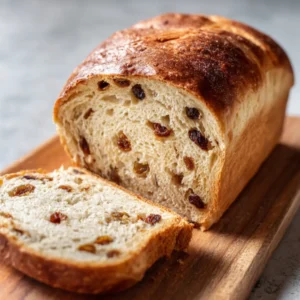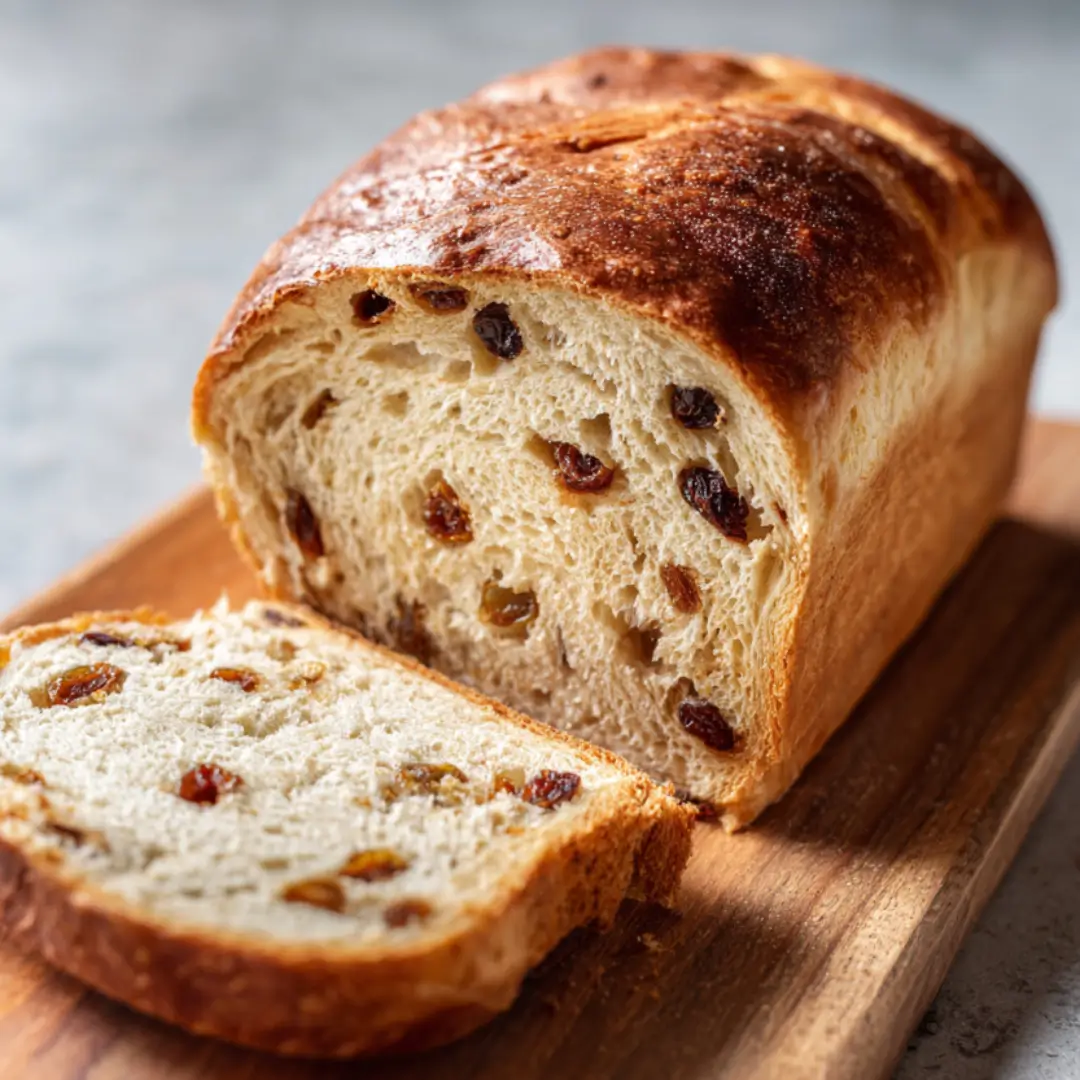Sourdough Cinnamon Raisin Bread is a timeless classic that combines the tangy depth of sourdough with the comforting warmth of cinnamon and sweet bursts of raisins. This bread is soft yet hearty, with a beautifully golden crust and an aroma that fills your kitchen with inviting spice.
Why We Love This Sourdough Cinnamon Raisin Bread Recipe
This recipe stands out because it combines the health benefits and natural leavening of sourdough with the beloved flavors of cinnamon and raisins. The long fermentation time develops complex flavors that you simply can’t get with quick breads or yeasted doughs. Plus, the slow rise improves digestibility and creates a wonderfully open crumb texture. You’ll appreciate how the dough transforms during the stretch and fold process, becoming stronger and more elastic with each turn. The addition of milk and butter enriches the dough, creating softness and moisture that keeps the bread fresh longer.
The cinnamon and nutmeg spices provide a fragrant, warm aroma that fills your kitchen, making the baking experience just as enjoyable as eating the bread. Raisins stud the bread with bursts of natural sweetness and chewiness, giving it a perfect contrast to the soft crumb. This recipe is versatile — whether you bake it for a weekend brunch or prepare loaves to share as gifts, it always impresses. It’s also a great way to build your confidence in working with sourdough starters and managing fermentation schedules.
Ingredients for Sourdough Cinnamon Raisin Bread
Starter:
- 30g sourdough starter
- 60g all-purpose flour or bread flour
- 60g water
The Dough:
- 550g all-purpose or bread flour (with at least 11% protein)
- All the sourdough starter prepared earlier
- 50g soft brown sugar
- 1 ½ teaspoons ground cinnamon
- ¼ teaspoon ground nutmeg
- 8g salt
- 120g raisins
- 250g whole milk
- 150g water
- 60g softened butter (room temperature)
Brushing:
- 2 tablespoons milk
How to Make Sourdough Cinnamon Raisin Bread Directions
Start your day by mixing together the starter ingredients: sourdough starter, flour, and water. Place this mixture in a clean jar and cover it loosely with a lid or cloth. Set it somewhere warm to encourage it to double in size over about six hours. This active starter is the heart of your bread, providing natural yeast and a slight tang.
Once your starter is ready, mix all the dough ingredients together in a large bowl, except the butter. This includes flour, brown sugar, cinnamon, nutmeg, salt, raisins, milk, water, and the sourdough starter. After combining these, add the softened butter. Use your hands to work the butter thoroughly into the dough. Initially sticky and soft, the dough will develop strength as you continue.
Place the dough into a clean bowl, cover it with a damp towel or lid, and let it bulk ferment in a warm spot for about four hours. During the first three hours, perform six sets of stretch and folds every 30 minutes. This technique helps build gluten strength, making your dough more elastic and easy to shape later. The dough will go from very loose to more structured and springy.
After bulk fermentation, cover the dough tightly and refrigerate it for up to 24 hours. This cold proof slows fermentation and allows flavors to deepen.
When ready to bake, take the dough out of the fridge. It will be firm and chilled. Turn it onto a floured surface and divide it into two equal pieces. Roll each piece into a rectangle roughly the length of your loaf pan. Then roll it up like a Swiss roll and place it into parchment-lined loaf pans.
Let the dough rise until doubled in a warm spot, which usually takes 4-6 hours. If your kitchen is cool, create a warm, humid environment by placing the pans in an oven with a bowl of hot water, turning the oven off.
Preheat your oven to 200°C (400°F). Brush the tops of your loaves with milk for a golden finish. Bake the loaves for 30-35 minutes until they are deep golden brown. If they brown too fast, cover loosely with foil. The bread is done when it sounds hollow when tapped underneath and reaches an internal temperature of 88-94°C (190-200°F).
Cool the bread on a wire rack before slicing to let the crumb set.
How to Serve Sourdough Cinnamon Raisin Bread
You’ll find this bread delightful whether fresh or toasted. For breakfast, slice it thick and spread with butter, honey, or your favorite nut butter. The cinnamon and raisin flavors come alive when warmed, making each bite comforting and delicious. Try it alongside a bowl of yogurt and fresh fruit for a balanced morning meal.
This bread also makes excellent toast for snacks. It pairs wonderfully with cream cheese or a mild cheese for a simple yet flavorful treat. Because the crumb is soft and moist, it’s great for making French toast, too. For a heartier snack, top toasted slices with mashed avocado or a drizzle of maple syrup.
When serving guests, slice the bread on a wooden board for an inviting rustic presentation. Adding a small bowl of butter or jam nearby invites everyone to customize their slice. The bread’s aromatic spices and natural sweetness make it a hit for any occasion.
Expert Tips for Sourdough Cinnamon Raisin Bread
To get the best results, keep your starter active and bubbly before using it. Feed it regularly and ensure it doubles within a few hours for the strongest rise. This impacts the dough’s fermentation and flavor development.
When mixing the dough, take your time incorporating the butter by hand. It helps create a tender crumb. If you use a stand mixer, a dough hook attachment works well, but avoid over-mixing as it can make the dough tough.
Stretch and folds are crucial — don’t skip them! They develop gluten, improve dough strength, and help trap gas bubbles for an airy crumb. Use a wet hand to prevent sticking while folding.
For proofing, maintain a warm environment around 25°C (77°F). If your kitchen is cold, use your oven as a proofing box by placing a bowl of hot water inside and turning the oven off. This gentle heat encourages steady fermentation.
When shaping, avoid deflating the dough too much. Be gentle to preserve the gas bubbles inside that help create lightness in the crumb.
How to Store Sourdough Cinnamon Raisin Bread
Store your bread in a paper bag or loosely wrapped in a clean kitchen towel at room temperature for up to two days to keep the crust crisp. Avoid plastic bags as they trap moisture and can make the crust soggy.
For longer storage, slice and freeze the bread in airtight bags. Toast slices straight from the freezer to bring back freshness. The bread keeps well for up to three months in the freezer.
If refrigerated, the bread tends to dry out faster, so it’s better to avoid storing it in the fridge unless you plan to consume it within a day.
Variation of Sourdough Cinnamon Raisin Bread
Experimenting with variations is a great way to keep this bread exciting. You can swap raisins for other dried fruits like chopped dates, dried cranberries, or chopped apricots to change the sweetness profile.
For a nuttier version, add chopped walnuts or pecans to the dough along with the raisins. Toast the nuts beforehand to enhance their flavor.
If you prefer a spicier bread, increase the cinnamon slightly or add a pinch of ground cloves or allspice. These warm spices complement the cinnamon and deepen the aroma.
To make a vegan-friendly loaf, replace the milk with a plant-based alternative like almond or oat milk and swap butter for coconut oil or vegan margarine. The sourdough starter remains the same.
For a lighter version, reduce the butter slightly and increase the water content to create a more open crumb.
FAQ About Sourdough Cinnamon Raisin Bread
What makes sourdough bread different from regular bread?
Sourdough bread uses a natural starter of wild yeast and bacteria instead of commercial yeast. This makes the bread tangier, improves digestion, and results in a chewier texture.
How long does it take to make sourdough cinnamon raisin bread?
The entire process, including proofing, takes about one and a half days. Most of the time is hands-off during fermentation and cold proofing.
Can I use all-purpose flour instead of bread flour?
Yes, but bread flour with higher protein content gives better gluten development and a chewier crumb. All-purpose flour works well, but the texture may be softer.
How do I keep the dough from sticking to my hands during mixing?
Wet your hands slightly or lightly oil them to prevent sticking while kneading and folding the dough.
Can I add more cinnamon or raisins?
Yes, you can adjust spices and raisins to your taste, but too much can affect the dough’s rise and texture.
How should I store leftover bread?
Keep it in a paper bag at room temperature for up to two days or freeze slices for longer storage.
Is this bread suitable for beginners?
With patience and following the steps, beginners can succeed. The stretch and fold technique helps manage sticky dough without traditional kneading.

Sourdough Cinnamon Raisin Bread
Equipment
- Mixing Bowl
- Food Processor
- Loaf Pans
- Wire Rack
Ingredients
- 30 g sourdough starter
- 60 g all-purpose flour
- 60 g water
- 550 g all-purpose or bread flour with at least 11% protein
- 50 g soft brown sugar
- 1.5 teaspoons ground cinnamon
- 1/4 teaspoon ground nutmeg
- 8 g salt
- 120 g raisins
- 250 g whole milk
- 150 g water
- 60 g softened butter room temperature
- 2 tablespoons milk for brushing
Instructions
- Mix sourdough starter, flour, and water in a clean jar. Cover loosely and let it rise in a warm spot for about six hours until doubled in size.
- In a large bowl, combine flour, brown sugar, cinnamon, nutmeg, salt, raisins, milk, water, and the prepared sourdough starter.
- Add softened butter and work it into the dough until fully incorporated. The dough will be sticky.
- Transfer the dough to a clean bowl, cover, and let it bulk ferment in a warm spot for about four hours, performing stretch and folds every 30 minutes for the first three hours.
- Refrigerate the dough covered for up to 24 hours to slow fermentation and enhance flavor.
- When ready to bake, turn the chilled dough onto a floured surface, divide it into two pieces, and roll each into a rectangle. Roll up each piece like a Swiss roll and place in parchment-lined loaf pans.
- Let the dough rise until doubled in a warm spot (4-6 hours). Preheat oven to 200°C (400°F).
- Brush the tops with milk and bake for 30-35 minutes until golden brown. Cool on a wire rack before slicing.
Send me this recipe!
Just enter your email below and get it sent straight to your inbox!


